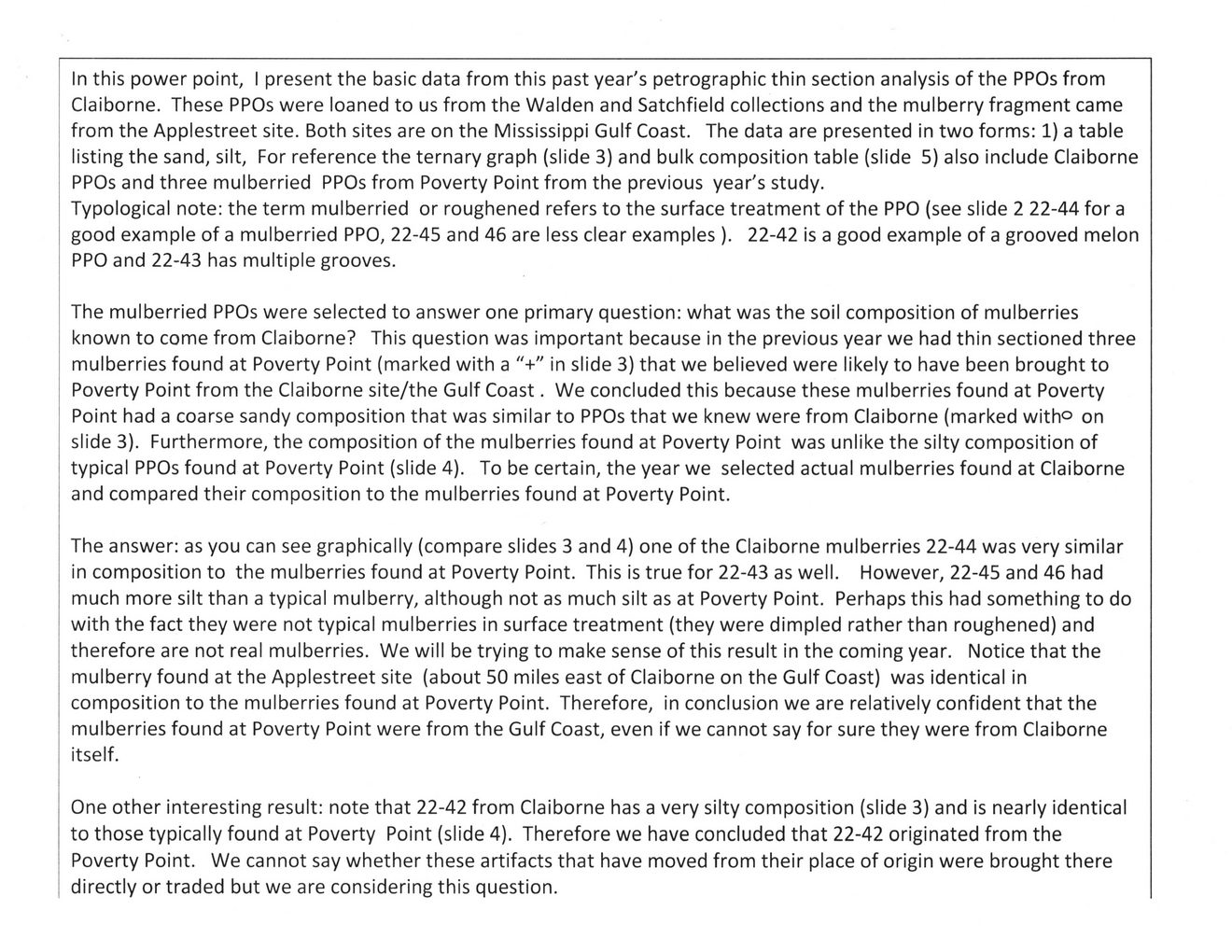This text was obtained via automated optical character recognition.
It has not been edited and may therefore contain several errors.
In this power point, I present the basic data from this past year's petrographic thin section analysis of the PPOs from Claiborne. These PPOs were loaned to us from the Walden and Satchfield collections and the mulberry fragment came from the Applestreet site. Both sites are on the Mississippi Gulf Coast. The data are presented in two forms: 1) a table listing the sand, silt, For reference the ternary graph (slide 3) and bulk composition table (slide 5) also include Claiborne PPOs and three mulberried PPOs from Poverty Point from the previous year's study. Typological note: the term mulberried or roughened refers to the surface treatment of the PPO (see slide 2 22-44 for a good example of a mulberried PPO, 22-45 and 46 are less clear examples ). 22-42 is a good example of a grooved melon PPO and 22-43 has multiple grooves. The mulberried PPOs were selected to answer one primary question: what was the soil composition of mulberries known to come from Claiborne? This question was important because in the previous year we had thin sectioned three mulberries found at Poverty Point (marked with a "+" in slide 3) that we believed were likely to have been brought to Poverty Point from the Claiborne site/the Gulf Coast. We concluded this because these mulberries found at Poverty Point had a coarse sandy composition that was similar to PPOs that we knew were from Claiborne (marked with0 on slide 3). Furthermore, the composition of the mulberries found at Poverty Point was unlike the silty composition of typical PPOs found at Poverty Point (slide 4). To be certain, the year we selected actual mulberries found at Claiborne and compared their composition to the mulberries found at Poverty Point. The answer: as you can see graphically (compare slides 3 and 4) one of the Claiborne mulberries 22-44 was very similar in composition to the mulberries found at Poverty Point. This is true for 22-43 as well. However, 22-45 and 46 had much more silt than a typical mulberry, although not as much silt as at Poverty Point. Perhaps this had something to do with the fact they were not typical mulberries in surface treatment (they were dimpled rather than roughened) and therefore are not real mulberries. We will be trying to make sense of this result in the coming year. Notice that the mulberry found at the Applestreet site (about 50 miles east of Claiborne on the Gulf Coast) was identical in composition to the mulberries found at Poverty Point. Therefore, in conclusion we are relatively confident that the mulberries found at Poverty Point were from the Gulf Coast, even if we cannot say for sure they were from Claiborne itself. One other interesting result: note that 22-42 from Claiborne has a very silty composition (slide 3) and is nearly identical to those typically found at Poverty Point (slide 4). Therefore we have concluded that 22-42 originated from the Poverty Point. We cannot say whether these artifacts that have moved from their place of origin were brought there directly or traded but we are considering this question.

Walden 028